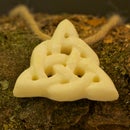Introduction: Double Wood Yin Yang Pendant
As my other instructables this is made with household tools such as saws, drill bits and a Dremel. I am proud of that because I see that I can get pretty good results even if I do not own fancy equipments as lathes or band saws.
This is a pendant that is made by two kinds of wood: the light one is spruce while the dark one could be walnut, but I am not sure. I found the piece of the latter wood in an old cellar with lots of wine barrels, thus it could be anything. It is the same wood that I used in my other instructable: https://www.instructables.com/id/Wooden-engagement-ring/
I usually call that symbol Yin and Yang but I am not sure if it is the right name. On Wikipedia they call it Taijitu [http://en.wikipedia.org/wiki/Taijitu] but I am not an expert on oriental culture. I apologize for any mistakes.
The close-up pictures were taken with a Pentax K10 D and a Tamron AF 90mm f/2.8 SP Di macro lens.
The other pictures, with a Pentax SMC-FA 50mm f/1.4. Unfortunately most of the project was carried out during the nights, so the pictures were taken with artificial light. I did my best with my camera.
Step 1: Materials
Step 2: Tools
- Mitre Box;
- Clamp;
- Wood saw;
- Small metal saw (used for the wood because it is very small);
- Very old drill;
- Polishing felt drill bit;
- Wax (a candle is good, I think);
- Files;
- Sandpaper;
- Drill bit to scrape;
- Dremel;
- Dremel drill press (this is not necessary but very usefull);
- A selection of Dremel bits;
- Compass to draw the symbol (again, not necessary but useful).
Step 3: Project
First of all I drew the symbol on a piece of paper with the compass. Of course it is not necessary but I gives the Idea of what you are planning to do.
Step 4: Cutting
With my unknown tool for cutting straight I cut two slices of wood about 8 mm thick.
On that tool you clamp the piece of wood and follow its guides with the saw.
Step 5: Drawing
With the compass I drew on the slices the desired designs. I did not think about the wood grains but next time I would try to make them parallel on the finished piece.
Step 6: Cutting the Pieces
From the slices I then cutted the small drop-like pieces using the Dremel Multi Purpose cutting bit and keeping the dremel on the drill press.
Remember to wear eye protection!
This was a bad idea, because that bit was not precise and just chopped of pieces of the wood. On the soft spruce I managed to use it anyways but on the dark wood it was really impossible. I had to hold it very strongly. After a few tries I gave up and with a lot of patience I manually filed away the excess of dark wood. On the dark wood was easier to use the files, though.
A very important warning is to keep a chunk of wood attached to the tail of the drop, otherwise it would be too thin.
Step 7: Finely Shaping the Pieces
Then I had to make the two pieces fit toghether, for this step I just used a manual rat-tail file (and a lot of patience).
Putting the pieces besides each other you get a felling of where there is too much wood. You want to make them as symmetric as possible and regular. To see if there were tiny gaps left over I holded the two pieces gainst a strong light.
Step 8: Preparing the Epoxy Glue
I kept a little bit of the sawdust to mix it with the epoxy glue to fill any gaps left over. To mix the sawdust and the epoxy you have to use an excess of epoxy because it is easier to hadle it.
This had to be a quick step because the epoxy is a quick hardening glue.
Step 9: Gluing
- With the mixing stick I put a lot of glue on the inner sides of the drop-like pieces (on both of the pieces);
- Pressed them against each other firmly;
- Using a clamp I holded them;
- I let it cure for a whole day, just in case, even if on the box they guarantee the hardening time to be 5 minutes;
Step 10: Getting to the Round Shape
Using the small metal saw I cut around the piece to make it round. Then I manually filed it till the round shape.
Step 11: Getting to the Desired Thickness
I tried to scrap off the excess of glue using a Dremel grinding stone bit (n. 952), but I just got the bit all dirty with glue and rendered it useless. So I had to cut it with a hobby knife. See the picture of the bit to have an idea of this.
After a lot of filing I realized that I had another scaping bit for the dremel and used it with a lot of success, till the desired shape. I wanted a circular and rounded shape.
Step 12: Drilling the "eyes"
To make the two "eyes" of the drop-like pieces, I used a bit that was as thick as a toothpick ad drilled two passing holes.
I then put the toothpick through the hole on the dark side and cutted it near the surface. After a little bit of filing again it blended on the surface of the piece.
Since the hole was a little bit smaller than the toothpick I did not use any glue and just stucked it there.
I left the dark "eye" just as a hole because I did not have any dark toothpick!
Step 13: Drilling the Necklace Hole
I then drilled the hole on the side, where the necklase should pass. Holding it firmly I drilled through it trying to go as straight as possible.
But DISASTER! I did not drilled it straight and came up outside on the side. I saw it in desperation and helpless.
With hindsight I would suggest to drill the hole before filing it down to the desired thickness (id est before step 11), thus it is still possible to save the situation.
Anyways, after the side hole I used the sandpaper to make the piece finally well rounded and to scrap off the uneven sides of the holes.
Step 14: Waxing
To protect the pendant I put some wax on it. I scaped the wax with the polishing felt and then passed on the wood surface to make it shiny.
To give a last pass I used a cloth.
Step 15: Done!
I am really satisfied with the result!
It surely has some flaws, first of all the side hole but on the front you can see that the dark piece is not well rounded. Apparently there was a gap that was filled with the dark glue. Also the grains of the two woods are in random angles, maybe making them parallel would look better.
Adding a small discrete necklace it looks very good.
Putting these worries aside I am still very proud of the work, especially because I used very simple tools that anyone can have at home whithout a big investment of money.

Finalist in the
Make It Stick Contest 2

Participated in the
Pocket-Sized Contest

Participated in the
4th Epilog Challenge













